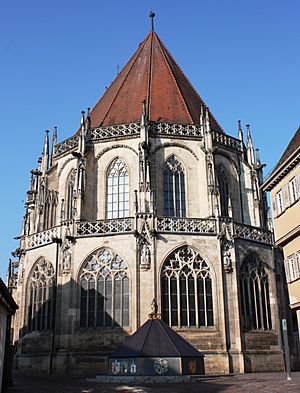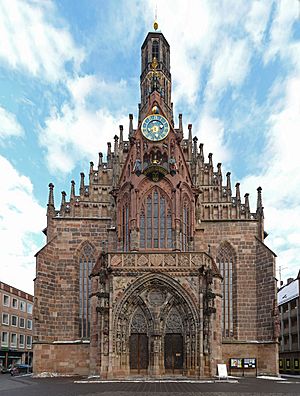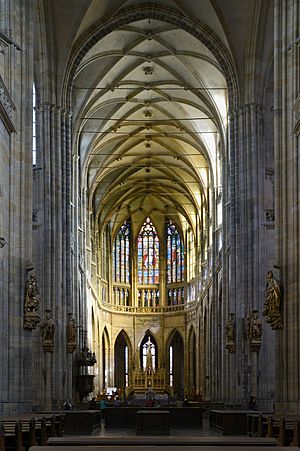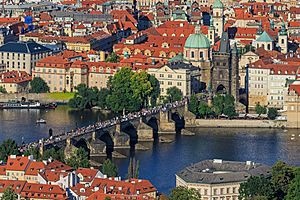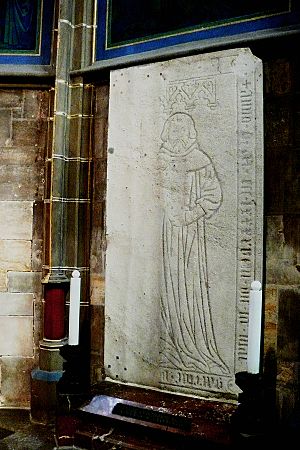Peter Parler facts for kids
Quick facts for kids
Peter Parler
|
|
|---|---|
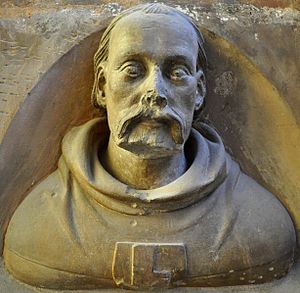
Self-portrait in stone at St. Vitus Cathedral, c. 1370
|
|
| Born | 1333 Schwäbisch Gmünd,
Holy Roman Empire |
| Died | 13 July 1399 (aged 68–69) |
| Nationality | German, Bohemian |
| Other names | Peter von Gemünd Petr Parléř |
| Occupation | Architect |
| Children | Johann Parler Wenzel Parler |
| Parent(s) | Heinrich Parler the Elder |
| Buildings | Frauenkirche St. Vitus Cathedral Charles Bridge |
| Design | Late Gothic |
Peter Parler (German: Peter von Gemünd, Czech: Petr Parléř, Latin: Petrus de Gemunden in Suevia; 1333 – 13 July 1399) was a famous German-Bohemian architect and sculptor. He came from the Parler family, a group of master builders. Peter and his father, Heinrich Parler, were two of the most important and influential builders of the Middle Ages.
Peter was born and learned his skills in Schwäbisch Gmünd. He worked on many important buildings in places like Strasbourg, Cologne, and Nuremberg. After 1356, he moved to Prague. Prague was the capital of the Kingdom of Bohemia and a very important city in the Holy Roman Empire. In Prague, he created his most famous works: St. Vitus Cathedral and the Charles Bridge.
Contents
Peter's Early Life and Training
We don't know much about Peter Parler's very early childhood. His father, Heinrich Parler the Elder, was a stonemason who worked on Cologne Cathedral. Around 1333, when Peter was born, his father was asked to build a large new church in Schwäbisch Gmünd. This church was called Holy Cross Minster.
Peter started working with his father on the church when he was still young. By 1351, he was helping lay the cornerstone for the choir section. This is likely where he finished his training as a builder. The way the choir was designed, with a continuous balustrade (a low wall with a railing), became a special feature of his style. The arched part of the church's southern entrance can also be linked to Peter. The designs created by Peter and his father at Holy Cross Minster were very special. They marked a big step forward in Late Gothic building and sculpture.
After his training, Peter went on his "Wandering Years" (German: Wanderjahre). This was a Medieval German tradition where craftsmen traveled to different places to work and learn. During these travels, he learned important building techniques used in Central Europe. He visited Cologne and probably Paris. He definitely spent time in Strasbourg, as his later buildings show he knew a lot about Strasbourg Cathedral. In Cologne, he met Druda (Gertrud), the daughter of another architect. They got married and had four children: three sons and one daughter. Two of his sons also became famous master builders.
Some historians think Peter might have traveled to England during this time, but it's not certain. This idea comes from some clever building tricks he used later that seemed to come from first-hand experience. However, it's more likely he learned these methods in Strasbourg. Masons in Strasbourg used building methods from western England in the late 1200s. Since Peter worked there, he could have learned them there. For example, the special vaults he designed later at St. Vitus Cathedral were probably inspired by the St. Catherine Chapel in Strasbourg Cathedral.
Working in Nuremberg
After 1352, Peter joined the building team at the Frauenkirche in Nuremberg. He worked as the parlier, which means the chief assistant on the building site, alongside his father. We don't know the exact date he started or his exact role. The church's foundations were laid in 1351. Charles IV, Holy Roman Emperor, wanted this church to be a place for important imperial ceremonies. You can see this in the carved coats of arms of the Emperor, the seven Prince-electors, and the city of Rome. Here, we can see the first sculptures that were definitely made by Peter, including a figure of Zacharias.
Charles IV also ordered the building of Wenzelsburg Castle near Nuremberg. This castle was built on the ruins of an older one. Its impressive design is clearly linked to the Parler family, and Peter likely worked there as a sculptor. By 1355, Charles IV was very impressed with their advanced style. He invited Peter to work in Prague, which was the capital of the new Kingdom of Bohemia and the Emperor's main city. The exact year Peter moved to Prague is a bit unclear. Most researchers now believe it was 1356. This fits with breaks in construction in both Nuremberg and Prague. It also means he was at least 23 years old when he got the job.
Prague: A Golden Era
When Charles IV became King of Bohemia in 1347, he made Prague his capital. At that time, Prague had two main towns on opposite sides of the Vltava river: the Old Town and the Lesser Town with Prague Castle above it. In 1348, Charles ordered the building of the New Town next to the Old Town. He also founded Charles University, began rebuilding the castle, and restarted work on the cathedral. To achieve all this, he hired the best architects he could find.
The first architect was Matthias of Arras, who died in 1352. When Charles was elected Holy Roman Emperor in 1355, he decided to make Prague the most important capital in Central Europe. He hired Peter Parler to make this grand vision a reality. This time became known as Prague's "golden era." Prague soon became one of the largest cities in Europe, after places like Constantinople, Paris, and Granada.
St. Vitus Cathedral
When Peter arrived in Prague in 1356, at just 23 years old, his first job was to take over the building of St. Vitus Cathedral. Work on the cathedral had slowed down since Matthias of Arras died in 1352. It showed how talented Peter was that such an important building was given to such a young architect. Peter continued building St. Vitus from the parts that were already started, like the ambulatory and chapels. He slowly changed Matthias's original plans, but he always kept the first vision in mind.
Charles Bridge
In 1342, before Charles IV became king, the old Romanesque Judith Bridge over the Vltava river was badly damaged in a flood. It was the first stone bridge connecting the two sides of the city. In 1357, Charles asked Peter to build a new bridge to connect the growing city, which now had four districts. The first foundation stone was laid in a special ceremony with the Emperor on 9 July 1357, at 5:31 am. We know the exact time because the architect had the special number 135797531 carved into the bridge's tower. This number was chosen by royal astrologers as the luckiest time to start building. Because the project was so complex and there were many other buildings being built, the bridge wasn't finished until 1402.
Peter Parler also built the east tower of the bridge, called the Old Town Bridge Tower. Its arch has a special "net vault" design, which was the first of its kind in Bohemia.
Other Important Works
Besides the cathedral and the bridge, Peter was also the main designer for the New Town of Prague. He also built the All Saints' Chapel inside the Royal Palace at Prague Castle. After a fire in 1541, it was redecorated in the Baroque style. Between 1360 and 1378, Parler built the chancel (the area around the altar) of the St. Bartholomew church in Kolín. Peter also created many tombs, shrines, and sculptures in and around Prague, including in Kutná Hora.
Peter's Family and Personal Life
The Parler family became very large, and its members worked on Gothic buildings all over Central Europe and Northern Italy. Peter's part of the family started when he married his first wife, Gertrude. We don't know their exact wedding date, but by 1360, they had three sons and a daughter:
- Johann Parler the Younger: Born around 1359, he learned his skills in Prague. He worked with his father on St. Vitus Cathedral. Johann took over his father's role as the cathedral's master builder in 1398. He also became the master builder of St. Barbara's Church, Kutná Hora, which is now a UNESCO World Heritage Site.
- Nikolaus Parler: He became a clergyman and worked as a canon (a type of priest) in Prague from 1380 to 1398. We don't know much else about him.
- Wenzel Parler: Born around 1360, he also trained in Prague. He worked with both his father and brother Johann at St. Vitus Cathedral in the 1390s. Later, he became the master stonemason at St. Stephen's Cathedral in Vienna.
- Their daughter: Around 1383, she married a man named Michael from Cologne. He might have been the son of another cathedral architect.
After 1360, Peter owned a house in Prague Castle Square and was chosen as a city alderman (a local official). His first wife, Gertrude, died in the late 1360s. In 1370, he went back to Cologne to deal with her inheritance. He then married Elisabeth Agnes von Bur in 1380. In the same year, he bought a second house on Castle Square. From this marriage, two more children were born: Johann, who might have become a stonemason in Zagreb; and Paul, about whom we know nothing. He might have had other children too. Peter gave both houses to his second wife and their children.
Peter became a citizen of Prague in 1379. By the time he was old, he was a wealthy man and still working as an architect. His name appears as "Cathedral Master" (German: Dombaumeister) on a panel at St. Vitus as late as 1396. He died in Prague in 1399 and was buried at St. Vitus Cathedral. His sons Peter and Wenzel continued his important work.
Peter Parler's Lasting Impact
Peter Parler was one of the most famous and important craftsmen of the Middle Ages. The building styles developed by him and his father became known as the "Parler style." This style spread all over Central Europe. Important examples include: St. Martin's Church, Landshut (started 1389); St. Lorenz, Nuremberg (nave started 1400); St. George's Minster, Dinkelsbühl (started 1448); and St. Stephen's Cathedral in Vienna (south tower started 1368). Many other examples can be found across the Hanseatic League, from the Netherlands to Poland. You can even find examples in Scandinavia, like at St. Mary's in Helsingør, Denmark.
To show how far his ideas traveled, look at Seville Cathedral, which was started in 1402. Today, it is still the largest Gothic cathedral in the world. The usual tall, vertical look of the main space is changed by a balustrade (a low wall with a railing) near the upper windows. This balustrade, with its widely spaced vertical bars and its position, is exactly like Peter Parler's original design for the western parts of St. Vitus’ Cathedral. Building at Seville Cathedral continued until 1506.
During the Hussite wars (1419–1434), the lands of Bohemia were badly damaged. Even though his buildings still stand, many of Peter Parler's sculptures were destroyed. However, a portrait of him, carved by his own hand, can still be seen in the Domgalerie at St. Vitus Cathedral.
Asteroid Named After Peter Parler
An Asteroid was named in honor of Peter Parler. It's called 6550 Parléř. It was discovered by Antonín Mrkos at Kleť Observatory on 4 November 1988.
The Peter Parler Prize
The "Peter Parler Prize" was created in 1994 by the German Foundation for Monument Protection. It is given out every two years at a big exhibition in Nuremberg. The prize honors people who have done outstanding work in preserving cultural heritage. The winner receives a special bust of Peter Parler and 15,000 Euros. In 2015, the prize went to August Weber and Helmut Schneider for their restoration work at St. George's church in Ulm.
Major Buildings and Designs
Buildings Peter Parler Worked On
- Heilig-Kreuz-Münster, Schwäbisch Gmünd (finished around 1351), consecrated 1410.
- Frauenkirche, Nuremberg (1352–1356)
- Wenzelschloss, Lauf an der Pegnitz (1355–1356)
- St. Vitus Cathedral, Prague (1356–1396)
- The chancel, sacristy, and tower
- Chapel of St. Wenceslas
- Golden Gate
- Charles Bridge, Prague (1357–1402)
- Karlštejn Castle (1357–1365)
- St. Bartholomew's Church, Kolín (1360–1378)
- Old Town Hall, Prague (1360–1381)
- Its chapel
- Its bay and stone decorations
- Old Town Bridge Tower, Prague (1370–1380)
- Church of the Assumption of the Virgin Mary and Charlemagne, Prague (consecrated 1377)
- All Saints Church, Prague (1372–1386)
- Church of Our Lady before Týn, Prague (choir started 1380)
- Karolinum, Prague (1383–1386)
- Its gothic bay
- St. Barbara's Church, Kutná Hora (begun 1388)
Architectural Drawings by Peter Parler
- Drawing of the choir and western facade of St. Vitus Cathedral (black ink on parchment, 132 x 52.5 cm), kept in Vienna.
- Drawing of the south tower of St. Vitus Cathedral (black ink on parchment, 106 x 93 cm), also kept in Vienna.
Images for kids
-
The famous Charles Bridge.
See also
 In Spanish: Peter Parler para niños
In Spanish: Peter Parler para niños
- Parler family
- Czech Gothic architecture


